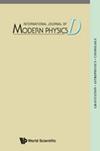Confronting the Chaplygin gas with data: background and perturbed cosmic dynamics
IF 2.1
4区 物理与天体物理
Q3 ASTRONOMY & ASTROPHYSICS
引用次数: 3
Abstract
In this paper, we undertake a unified study of background dynamics and cosmological perturbations in the presence of the Chaplygin gas (CG). This is done by first constraining the background cosmological parameters of different Chaplygin gas models with SNeIa and [Formula: see text] data for detailed statistical analysis of the CG models. Based on the statistical criteria we followed, none of the models has substantial observational support, but we show that the so-called “original” and “extended/generalised” Chaplygin gas models have some observational support and less observational support, respectively, whereas the “modified” and “modified generalised” Chaplygin gas models miss out on the category less observational support, but cannot be ruled out. The so-called “generalised” cosmic Chaplygin gas model, on the other hand, falls under the no observational support category of the statistical criterion and can be ruled out. The models which are statistically accepted are considered for perturbation level in both theoretical and observational aspects. We also apply the [Formula: see text] covariant formalism of perturbation theory and derive the evolution equations of the fluctuations in the matter density contrast of the matter–Chaplygin gas system for the models with some or less statistical support. The solutions to these coupled systems of equations are then computed in both short-wavelength and long-wavelength modes. Then we feed these observationally restricted parameters into the analysis of cosmological perturbations to address the growth of density contrast through redshift. Using the most recent linear growth of the data [Formula: see text], CG models are considered to study the linear growth of the structure.用数据面对Chaplygin气体:背景和扰动的宇宙动力学
在本文中,我们对Chaplygin气体(CG)存在下的背景动力学和宇宙学扰动进行了统一的研究。这是通过首先用SNeIa和[公式:见文本]数据约束不同Chaplygin气体模型的背景宇宙学参数来完成的,以便对CG模型进行详细的统计分析。根据我们遵循的统计标准,没有一个模型具有实质性的观测支持,但我们表明,所谓的“原始”和“扩展/广义”Chaplygin气体模型分别具有一定的观测支持和较少的观测支持,而“修改”和“修改广义”Chaplygin气体模型缺少较少的观测支持,但不能排除。另一方面,所谓的“广义”宇宙Chaplygin气体模型属于统计标准的无观测支持范畴,可以排除。在理论和观测两个方面考虑了统计上接受的模型的摄动水平。我们还应用了微扰理论的协变形式,对具有或多或少统计支持的模型推导了物质- chaplygin气体系统物质密度对比波动的演化方程。然后在短波和长波模式下计算这些耦合方程组的解。然后,我们将这些观测受限的参数输入到宇宙学扰动分析中,以解决通过红移引起的密度对比增长问题。使用最新的线性增长数据[公式:见文本],考虑CG模型来研究结构的线性增长。
本文章由计算机程序翻译,如有差异,请以英文原文为准。
求助全文
约1分钟内获得全文
求助全文
来源期刊

International Journal of Modern Physics D
地学天文-天文与天体物理
CiteScore
3.80
自引率
9.10%
发文量
181
审稿时长
4-8 weeks
期刊介绍:
Gravitation, astrophysics and cosmology are exciting and rapidly advancing fields of research. This journal aims to accommodate and promote this expansion of information and ideas and it features research papers and reviews on theoretical, observational and experimental findings in these fields. Among the topics covered are general relativity, quantum gravity, gravitational experiments, quantum cosmology, observational cosmology, particle cosmology, large scale structure, high energy astrophysics, compact objects, cosmic particles and radiation.
 求助内容:
求助内容: 应助结果提醒方式:
应助结果提醒方式:


